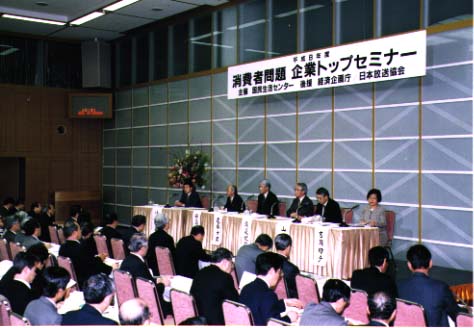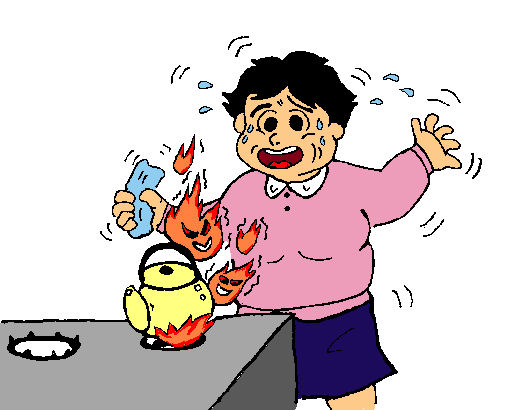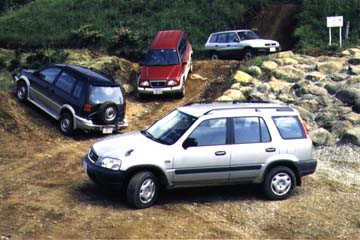NCAC NEWS(Vol.8,No.4)
INDEX
- Seminar on Consumer Affairs for Executives
- Burns Caused by Clothes Catching on Fire
- Results of Product Tests---Small SUVs
- List of Product Tests in FY 1996
CONTENTS
Seminar on Consumer Affairs for Executives

The National Consumer Affairs Center of Japan (NCAC) holds about 30 seminars a year for the staff of local consumer affairs agencies, consumer counselors in local consumer centers, people engaged in consumer activities, and corporate staff.
On February 19, 1997, NCAC held a seminar on the theme of "The Distribution Revolution and Social Responsibility of Corporations - Thinking About Products and Services for the 21st Century." This seminar was for top managers in charge of consumer-related departments at various companies (such as presidents and executive directors), with the aim of providing information related to consumer problems and a promoting a consumer-oriented stance on the part of companies.
This seminar is held once each year. This year's seminar took place at a time when the Japanese economy is undergoing a great transformation due to changes such as deregulation, the re-examination of traditional business practices, and the development of an infrastructure for an advanced information society. Giventh is broader context, the seminar took up questions such as the vitalization of the market through new entries, elimination of the gaps between domestic and overseas prices, environmental protection, the role of products and services foran aging society, and the role of consumer protection and role of companies in the 21st century.
At the opening of the seminar, President Shogo Oikawa of NCAC gave a talk onthe role of NCAC and high-priority activities for 1997, followed by a speech entitled "The State of the Japanese Economy and People's Life" by the Director - General of Social Policy Bureau, Economic Planning Agency.
Following this, the chief of a private thinktank gave a lecture entitled "Business Management in the 21st Century and Social Responsibility." Finally,there was a panel discussion on the theme, of "The Distribution Revolution and Products and Services." The panelists included the director of an appliance maker, a scholar, a representative of the Fair Trade Commission, a representative of a consumer organization, and a vice-president of a distributor. They stated their views directly from their own perspectives.
Burns Caused by Clothes Catching on Fire
According to the Consumer Injury Information System operated by NCAC, a large number of "accidents where the victims' clothing caught fire and caused a burn, "have been reported to NCAC, local consumer centers, and cooperating hospitals. These cases include truly tragic accidents in which the victims had critical burns all over their body, resulting in death.
1. Number of accidents
Twenty-two such accidents were reported for fiscal 1993, 32 cases in fiscal 1994, 43 cases in fiscal 1995, and 33 cases for the period from April to December of 1996. The total number for the period 1993-1996 is 130 cases.
2. Overview of the accidents
By age grouping, the victims in 22 cases were in the 30's, those in 19 cases in the 40's, and those in 17 cases were in the 50's.
Of the 82 cases that were reported to the cooperating hospitals, 2 cases resulted in death. Of the remaining 80 cases, 40 cases (50%) were serious and required hospitalization.
The body parts burned were: forearm (21 cases, 25.6%), leg (17 cases, 20.7%), and whole body (13 cases, 15.9%). Eight out of the 13 whole-body cases were suffered by elderly persons over 60.
The situation in which the accident occurred was "while cooking" (39 cases, 30%) and "while smoking, or immediately after smoking" (35 cases, 26.9%) andso on.
Also, 19 cases can be called "flash over phenomena." (Fire begins on the fluff of the surface of the fabric and rapidly spreads all over). This phenomenon is most likely to occur with cotton, rayon and other fabrics with fluff. Also, more fluff results from washing, and the surface flash occurs more quickly. Even if it does not cause a burn directly, the person may be surprised and drop a cooking utensil or kettle that he/she is holding, leading to burns from the boiling water. Thus, the danger of secondary damage is large.
The sources of fire included "gas cooking stoves," "lighters," "fireworks," and "candles."
The types of clothing that caught fire, included, "dress shirts," "cardigan sweaters," "pajamas and other night clothes." In the case of dress shirts, mostof the accidents were caused when a victim put his cigarette lighter into the pocket while smoking. Cardigan sweaters often caught fire while cooking.

3. Cases
- The cotton clothes that a 55-year-old housewife was wearing caught on fire from a gas range and went up in flames. She tried to put it out by hand quickly but failed. She turned on the water faucet and tried to put the fire with water but failed again. She ended up with burns on her midsection.
- An 87-year-old man was wearing a nylon garment and lit a cigarette lighter. While he was distracted by the newspaper that he was reading, his clothes caught on fire. His entire body was covered in flames, causing burns on 70% of his body, which required hospitalization.
- 9-year-old boy was playing with a cigarette lighter and spilled fuel oil on his clothes, causing them to catch on fire. He suffered burns on 30% of his body.
4. Legal regulations
There are no legal regulations to prevent this type of accident. However, since the PL Law was put into effect, labels on the need to exercise caution about "the flash over phenomenon" have been used more often.
With the guidance of the Tokyo Fire Department, the Japan Fire Retardant Association has established standards for fire-retardant capability and allows those products that meet the standards and the toxicity test to use "Flame-retardant" label. Flame-retardant products such as pajamas, bedding, and aprons, are on the market for household use but they are not distributed that widely. Also, associations of textile and apparel makers are each calling on member companies to make greater efforts to prevent of fire accidents.
RESULTS OF PRODUCT TESTS
Small SUVs
Recently, sports utility vehicles (SUVs) have been very popular. Small SUVs are particular popular. This time NCAC examined the following four models that are in the Japanese market: Escudo Nomad V6-2000 (Suzuki), RAV4 J V (Five)(Toyota),CR-V (Honda), RVR Sports Gear (Mitsubishi).

1. Driving experiences
When we compared the test vehicles with sedans on city streets, their riding comfort was not as good as the sedans: their suspensions were rigid and they rolled more when cornering. On the off-road test, the three models with no transfer (RAV4 J V, CR-V and RVR Sports Gear) had relatively weak engine braking when driving down steep hills. All the tested models have adequate performance for commuting and shopping and holidays outings (that is, off-road use that does not require transfer).
2. Safety
Small SUVs tend to have a large blind spot in the driver's field of vision, because they have a spare tire on the rear. Thus, even when a small child is in the back of the vehicle, the driver usually will not be able to see him or her. Therefore, it is desirable that all the tested models be modified to improve the rear vision by measures such as lowering the position of the spare tire or enlarging the rear window.
The RAV4 J V have ABS and a driver's-side airbag as a standard equipment, while other models offer them as options, so it is necessary to check when purchasing.
3. Utility of the interior space
Cargo space : When the rear seats are folded, the cargo space is large, but with the maximum number of passengers, the cargo space is about the same as that of a sedan.
Interior space :All the tested models promote passengers being able really relaxin the car and use reclinable seats. However, the specific form of the reclinable seats varies by model. In the case of the CR-V, there is an even flat space from the sitting part of the front seat to the back of the rear seat. With the Escudo Nomad V6-2000, however, the seatbacks do not fold down fully, so the flat space extends only to the edge of the rear seats.
What needs to be remembered is that a reclinable seat is to be used only when the car is stopped. In the driver's handling instructions (for all the test models), driving with people or cargo on a reclined seat is prohibited. If you have anyone or any cargo on a reclined seat while driving and brake suddenly, the passenger or cargo may be thrown out of the vehicle, resulting in a serious accident.
Also, in terms of vehicle driving and handling, there is no strange or awkward feeling in comparison with regular sedans.
4. Catalogs and instructions
In the catalogs of all the test models, there are photographs and catch phrases that project an image of mountain roads and off-road driving. For example, we see catch phrases such as: "From on-road to off-road. Let's drive on any road that we feel like driving." On the other hand, a part of the driver's handling instructions states an important caution: "Please do not use for off-road driving."
That is to say, small SUVs are not designed for driving on unpaved, steep hilly or roads with big rocks. However, because of their height from the ground to the floor compared to regular passenger cars, they can be driven on roads that are somewhat rough.
List of Product Tests in FY 1996
NCAC carried out comparative tests for 13 product items during FY 1996. The results and findings from these product tests were announced in a monthly magazine, "Tashikana-Me"(Critical Eyes). We will introduce the items that were announced for your reference.
| date of release | tested products |
|---|---|
| 1996. Apr. | Brassirers |
| 1996. May | Oven Toasters |
| 1996. Jun. | Home Garbage Disposals - part 1 |
| 1996. Jul. | Lotions with Labels which use misleading word "white" |
| 1996. Aug. | 28-inch Wide TVs with Built-in BS (Broadcasting Satelite) Tuner |
| 1996. Sep. | Food Products that Claim to Provide Nutrients such as Vitamins and Minerals |
| 1996. Oct. | Environmentally-Friendly Apparels |
| 1996. Nov. | Home Garbage Disposals - part 2 |
| 1996. Dec. | Panty Stockings |
| 1997. Jan. | Small SUVs Digital cameras |
| 1997. Feb. | Lunch Boxs sold at Convenience Stores |
| 1997. Mar. | Belts for Carrying Infant |
